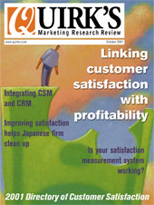Squeeze play
Editor’s note: Bill Barnes is a vice president of Cincinnati-based Burke Customer Satisfaction Associates.
In today’s economy, manufacturers of all kinds are caught in the squeeze between flat or declining selling prices and increases in costs for raw materials. Despite higher sales volumes, the overall revenue may not be increasing due to lower average selling prices. The margin squeeze comes when these companies experience increased raw material costs combined with flat or overall declining revenue.
In the past when raw material costs increased, these increases could usually be passed on through the value chain until it reached the consumer. However, the emergence of “super retailers” - retailers with enough purchasing power to force suppliers to reduce selling prices - has changed the ability for these price increases to be passed on in the value chain.
These super retailers like Wal-Mart and Home Depot have a lot of power over suppliers because they can simply go elsewhere with their lucrative orders. This cost-reduction pressure gets pushed down the value chain. Therein lies the squeeze - there is little opportunity for bargaining for a higher price.
As the value chain gets closer to basic raw materials like petrochemicals used in plastics and chemicals, these companies must accept the higher raw material costs. Basic petrochemical prices are strongly influenced by OPEC, which has recently controlled overall production better than in the past. This has kept supply and demand in more of a steady state that has resulted in higher selling prices, as evidenced by the higher prices at the pump and last winter’s heating bills.
The automotive sector is also an example of not accepting cost increases from raw material suppliers. In fact, Chrysler recently made announcements in the media on its strategy for improved profitability, which included saving money on raw materials. Chrysler will ask for and get price concessions from its suppliers. Which, in turn, will reduce its suppliers’ profits.
It has been demonstrated that there is no latitude with selling price and no latitude with raw materials costs. In addition, this squeeze is compounded by increased pressure from Wall Street for companies to continue to deliver quarter-to-quarter earnings increases.
Keeping in mind the fact that for most manufacturers, raw material costs and payroll costs account for 80 to 90 percent of the total revenue, management feels the pressure to do something to control the bottom line since market factors prevent them from increasing the top line.
Companies have a few choices of strategies that can minimize the squeeze impact. Common company reactions include:
1. A branding initiative. Branding is a great strategy for creating consumer pull-through and differentiation. Yet it can be expensive, time-consuming and difficult to measure in terms of effectiveness.
2. Niche market creation. Sometimes a company can create a market niche for its product or service. This then tends to diffuse the commodity pricing of products and services. This strategy also is time-consuming and will only work if a company’s competitors don’t employ the same strategy, otherwise you become a commodity again.
3. Staff reduction. This strategy appears to be the most common one in today’s markets due to the large impact payroll costs have in the total cost of goods. Reducing employees through layoffs can be done quickly but is extremely painful for management to implement. This strategy also severely damages employee morale. Usually staff reductions are decided by examining non-mission critical functions based on management’s view.
The bigger challenge with these approaches is that decisions are made without a clear understanding of what the customer truly values from the business and what is driving the customers’ loyalty to the company’s products or services.
Integrating the voice of the customer
While a labor reduction decision may be right for a business based on market conditions that management did not plan for, resource reduction decisions can produce better results if they are made based on what the customer values and which product and service attributes are driving customer loyalty. This ends up being reflected in the ever-important top line or revenue.
The customer’s view of value is so important simply because they are the stakeholder with the money. The money for every employee’s paycheck originates from a paying customer. While this is a very obvious statement, many manufacturing companies become asset-driven versus customer-driven as they focus on how to consistently deliver profitable results. Therefore all resource decisions need to be made with a view of what the customer values. In fact any resource allocation decision should be made based on a balance of two questions:
1. Will it will reduce the cost of doing business?
2. Will it increase or decrease the customer’s desire to purchase?
Listening, understanding and making changes based on the voice of the customer should apply to staff reduction decisions or year-to-year budget setting. Resources should be allocated to the enterprise based on what the customer will pay for.
When decisions are made without customer data on resource allocation, organizations exhibit a “functional bias” in their decisions as to what is most important. For example, the research and development department says that new products are most important; the sales department says that maintaining business relationships is most important; supply-chain personnel say that the ability to deliver when promised is the most important, etc.
If customer research is designed correctly, then the voice of the customer will present a non-biased view. Traditional market research companies can help companies collect and analyze customer data. However those leading the way in today’s difficult market can provide the ever-critical deployment and improvement-planning component. Effective data deployment provides the organization the capability to align customer data to its operation data and aids the organizations in prioritizing internal process improvement efforts that will improve customer loyalty.
And, change-management programs that allow organizations to sustain process improvement must also be included in these deployment initiatives. Effective deployment happens when the customer data is used to implement appropriate internal process changes and resource allocation decisions.
